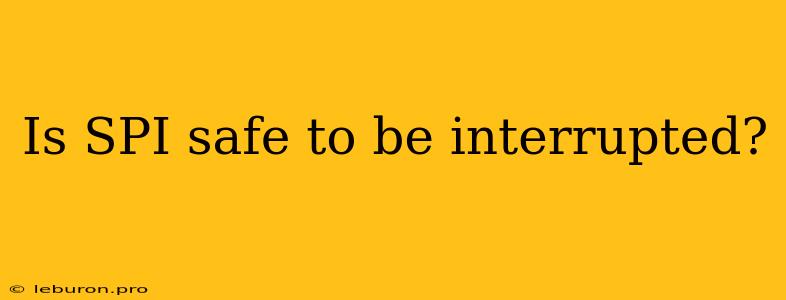The question of whether or not SPI (Serial Peripheral Interface) communication can be safely interrupted is a complex one, with the answer depending on the specific application and implementation. While SPI is a synchronous protocol designed for reliable data transfer, interrupting the communication process can introduce risks of data corruption or device malfunction. This article delves into the complexities surrounding SPI interruption, exploring the potential consequences, mitigating strategies, and best practices to ensure safe and reliable data exchange.
Understanding SPI Communication
SPI is a widely adopted serial communication protocol used in various applications, from microcontrollers and sensors to memory chips and display drivers. Its popularity stems from its simplicity, cost-effectiveness, and flexibility in supporting various data rates and device configurations. At its core, SPI relies on a synchronous exchange of data between a master device and one or more slave devices. The master device controls the timing and direction of data transfer, sending clock signals to synchronize the data flow with the slaves.
Key Components of SPI Communication
- Master Device: The device initiating the communication, controlling the timing and direction of data transfer.
- Slave Device: The device receiving or transmitting data, responding to the master's commands.
- MOSI (Master Out Slave In): The line carrying data from the master to the slave.
- MISO (Master In Slave Out): The line carrying data from the slave to the master.
- SCK (Serial Clock): The line providing the clock signal that synchronizes data transfer between the master and slave.
- SS (Slave Select): A line used to select a specific slave device for communication.
Potential Consequences of Interrupting SPI Communication
Interrupting an ongoing SPI communication can lead to several potential consequences, depending on the specific circumstances:
1. Data Corruption: Interrupting the data transfer while data is being sent or received can result in incomplete data packets, leading to corrupted data. This is particularly problematic for applications requiring accurate and complete information, such as sensor readings or data storage.
2. Device Malfunction: Depending on the specific device and implementation, interrupting the SPI communication can trigger unpredictable behaviors or even damage the device. Some devices may have internal states that require uninterrupted communication, and abruptly stopping the transfer could lead to unexpected results.
3. Timing Issues: SPI relies on precise timing for proper data transfer. Interrupting the communication can disrupt the clock signal, leading to timing inconsistencies that can result in data errors.
4. Synchronization Problems: Interrupting SPI can disrupt the synchronization between the master and slave devices. This can lead to misalignment of data packets and communication failures.
5. Hardware Damage: In some cases, especially with sensitive devices, interrupting SPI communication might cause hardware damage, particularly if the interrupt occurs during a critical phase of the data transfer process.
Mitigating Risks of Interrupting SPI Communication
While interrupting SPI communication inherently poses risks, several strategies can help mitigate the potential consequences:
1. Implement a Protocol for Safe Interruption: Define a protocol for safe interruption of SPI communication that ensures data integrity and device stability. For example, this could involve sending a specific command to the slave device to signal the end of the communication before interrupting the connection.
2. Use Interrupts Wisely: When using interrupts to handle external events, ensure they do not disrupt the SPI communication process. Prioritize essential tasks and avoid interrupting SPI transfer unless absolutely necessary.
3. Use Buffering Techniques: Employ buffering techniques to ensure data is not lost during interruptions. Buffering allows for temporary storage of data while the SPI communication is paused, mitigating the risk of data corruption.
4. Implement Error Handling Mechanisms: Implement robust error-handling mechanisms in your software to detect and recover from potential errors arising from interrupting SPI communication. These mechanisms can identify data corruption or communication failures and take corrective actions.
5. Consider Alternative Protocols: If interruptions are frequent or critical, consider alternative communication protocols that are inherently more robust against interruptions, such as I2C (Inter-Integrated Circuit) or UART (Universal Asynchronous Receiver/Transmitter).
Best Practices for Safe SPI Communication
Following best practices can minimize the risks associated with interrupting SPI communication and ensure reliable data transfer:
- Avoid unnecessary interruptions: Design your system to minimize interruptions during critical SPI communication phases. If possible, schedule tasks that may cause interruptions for periods when SPI is not active.
- Use appropriate timing: Ensure proper timing within your SPI implementation, taking into account the data rate and the device's requirements. Avoid delaying the clock signal or introducing unnecessary delays that might lead to communication errors.
- Implement error checking: Include error checking mechanisms in your SPI communication to detect and handle potential data corruption. This can involve CRC (Cyclic Redundancy Check) or other error detection methods.
- Test thoroughly: Thoroughly test your system under various conditions, including simulated interruptions, to verify the robustness of your SPI implementation and error handling mechanisms.
Conclusion
Interrupting SPI communication is generally not recommended due to the potential consequences for data integrity and device stability. While there are strategies to mitigate these risks, the safest approach is to avoid interrupting the communication process unless absolutely necessary. When interruptions are unavoidable, implementing a safe protocol, utilizing proper timing, and employing error-handling mechanisms can help minimize the risks and ensure reliable data transfer. Carefully considering the specific application and its requirements, as well as following best practices, can help ensure safe and successful SPI communication.
